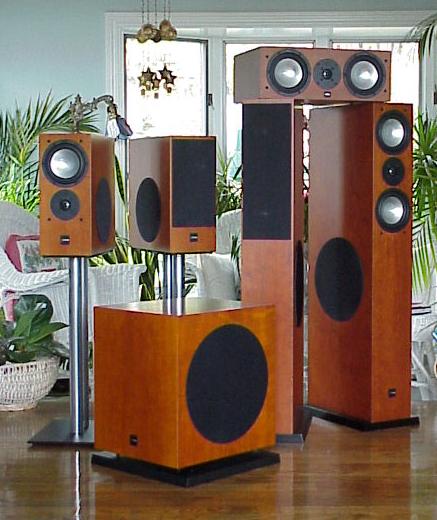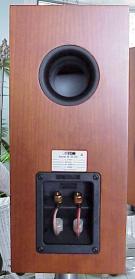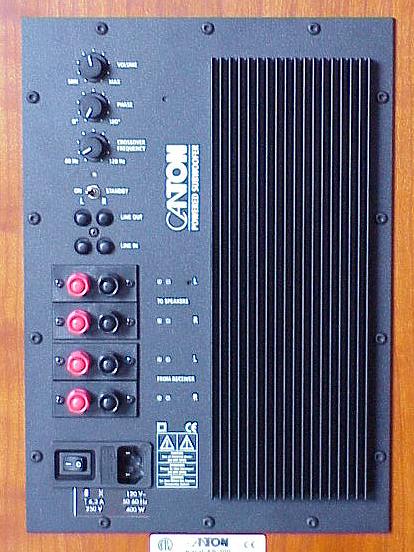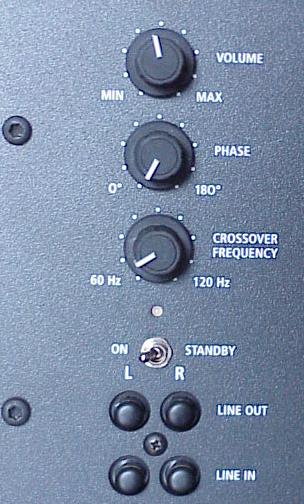Product Review - Canton Karat M 80 DC Floor-Standing Speakers, CM-7 Center Channel Speaker, M 30 DC Bookshelf Speakers, and AS-300 Powered Subwoofer - March, 2002 John E. Johnson, Jr.
|
|
Specifications: Drivers: M 80 DC: One 1" Metal Dome Tweeter, Two 6" Aluminum-Manganese Midrange Drivers, One 10" Cellulose-Graphite Woofer - Crossover 180 Hz/3.2 kHz; M 30 DC: One 1" Metal Dome Tweeter, One 6" Aluminum-Manganese Midrange Driver, One 8" Cellulose-Graphite Woofer - Crossover 180Hz/3.2 kHz; CM-7 DC: One 1" Metal Dome Tweeter, Two 6" Aluminum-Manganese Mid-Bass Drivers - Crossover 3 kHz; AS-300 - Two 12" Drivers - One Active, One Passive - Powered by 250 Watt RMS Amplifier MFR: M 80 DC: 22 Hz - 30 kHz; M 30 DC: 25 Hz - 30 kHz; CM-7: 32 Hz - 30 kHz; AS-300: 20 Hz - 150 Hz - Adjustable Phase 00 - 1800 Nominal Impedance: 6 Ohms Efficiency: M 80 DC - 88 dB/W/M; M 30 DC - 86 dB/W/M; CM-7 DC - 87.5 dB/W/M Size: M 80 DC: 44" H x 6 3/4" W x 16" D; M 30 DC: 15 1/2" H x 6 3/4" W x 15" D; CM-7: 6 3/4" H x 18" W x 14" D AS-300: 19" H x 14" W x 17" D Weight: M 80 DC: 71 Pounds Each; M 30 DC: 30 Pounds Each; CM-7 DC: 28 Pounds; AS-300: 74 Pounds
MSRP: M 80 DC -
$1,350/Each; M 30 DC - $850/Each; CM-7 DC - $650; AS-300 -
$1,700; Real Wood Veneer - Beech, Cherry (Shown Here), Black Ash, Silver
Lacquer
|
|
Canton Speakers; Web http://www.cantonusa.com |
Introduction
In a world where you sometimes have a company that is based here, but their products are made over there, I will begin by saying Canton speakers are manufactured in Germany where the company is based. They are not OEM'd in a country where the labor costs are cheap. So, Canton Karat speakers are expensive. The MSRP on the set of speakers shown here is $6,750. That is a chunk of change.
But, look at what you get: Real cherry veneer - even though wood grained vinyl now looks like the real stuff; Aluminum-manganese tweeters and mid-bass drivers; Cellulose-graphite woofers; Heavy well-damped cabinetry (the system arrived on a pallet).
One of the finishes available is silver lacquer (shown below), which I think is quite modern looking. However, I prefer the wood.
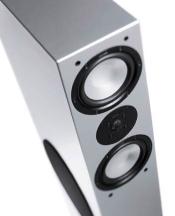
The Design
Aluminum drivers are now commonplace. What differentiates metal cones is the presence or absence of alloy. In the case of the Cantons, the cones are aluminum-manganese. At first, I thought this was a typo, because I am used to seeing aluminum alloyed with magnesium in metal cone drivers. But some research on the Internet turned up aluminum-manganese alloys sold by a number of companies. Aluminum by itself produces ringing (like a bell), so the addition of malleable metals like magnesium or manganese reduces the ringing. The problem is that forming the cone from the alloy is not easy. There is a tendency for the cone to crack or split during the forming process. That is why the inexpensive metal cone products tend to be aluminum alone.
The Canton Karat line is finished with real wood veneer on all sides, including the back and the bottom. Edges are very smooth, and I could not find any defects on any of the surfaces. You pay for this, but the beauty is worth it.
The M 80 DC (Floor-Standers) and CM-7 (Center Channel) are MTM (Midrange - Tweeter - Midrange) configurations, also called D'Appolito (after Joe D'Appolito, who originated it). This places the high frequencies coming from the center of the midrange. The M 30 DC has the midrange driver on top, the tweeter underneath, and the woofer (8") on the side. The M 80 DC also has its woofer on the side, but it is a 10" driver. The M 80 DCs and 30 DCs are marked as "A" and "B", which indicates that the woofer is on the left or right side of the enclosure. I set them up with the woofers facing each other, rather than away from each other.
The tweeter is covered with a metal grille, and also, there is a small disc at the center, for dispersion (photos below).

On the rear of the speakers are the port (flared) and bi-ampable five-way all metal, gold-plated binding posts. The mid-high drivers and woofer are connected with actual wire rather than metal strips. You disconnect the wires if you want to bi-amp or bi-wire the speakers.
|
|
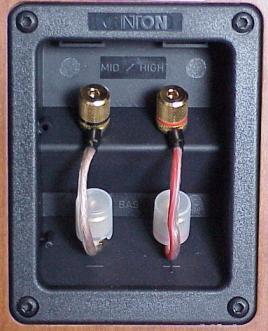 |
The subwoofer has two 12" drivers, one active and one passive. They are on opposite sides of the enclosure, with the power amplifier controls (shown below) in between. The close-up photo on the right illustrates the usual controls, including volume, variable phase, and crossover frequency. There are two power-on controls. One is the main power rocker switch at the bottom left, and the other is underneath the crossover frequency knob, which is for power always on vs. standby. There are some small plastic plugs in each of the sockets (RCA and speaker). You have to remove them from the sockets you are using, but just leave them in the ones you are not using. This keeps the sockets from accumulating dust. Nice touch.
|
|
|
Click HERE to go to Part 2 - The Sound
![]()
� Copyright 2002 Secrets of Home Theater & High Fidelity
Return to Table of Contents for this Issue.

